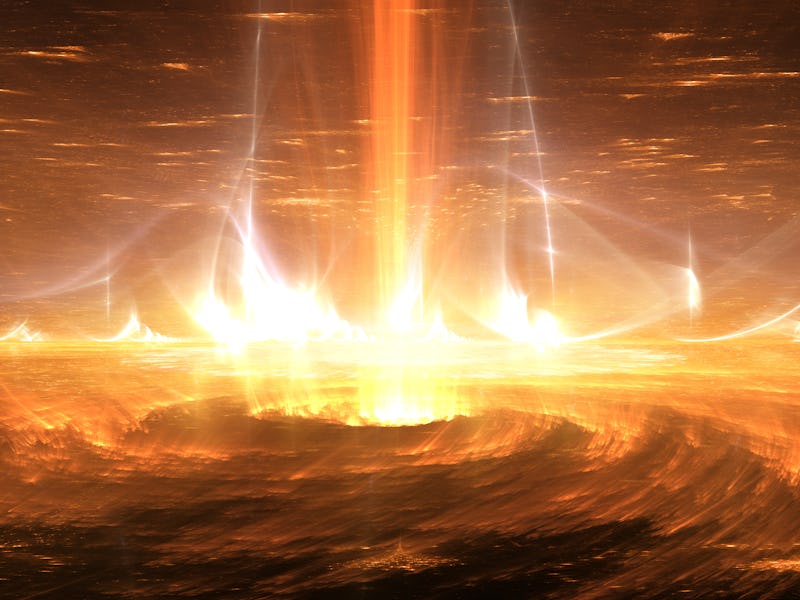What is the Epoch of Reionization? Inside one of the Webb Telescope’s prime targets
The early universe wasn't exactly known for its clear skies.

First, there was the Big Bang, and then there was light.
Roughly 400,000 years after our universe formed, the hot environment from the Big Bang finally began to cool. Before this moment, the universe was like one big, hot plasma. We then see the universe’s radiation emerge, allowing us to learn more about the physics of the cosmos by observing the light as a faint, ghostly background we see in certain wavelengths today.
Then came the first stars’ effect on that environment 400 million years ago, called the Epoch of Reionization. It is a fascinating era we are just beginning to understand — the first stars and galaxies cleared a universal haze and opened up the vistas of the universe.
What happened after the Big Bang?
Let’s start with the Big Bang. The universe was birthed 13.8 billion years ago, and a lot happened within even the first few minutes.
As the universe expanded rapidly, temperatures cooled. Then protons and neutrons (elements of today’s atoms) began to combine. Their first combination was likely an isotope (or type) of hydrogen called deuterium. Over time, deuterium also combined to create helium.
This environment remained incredibly hot for about 380,000 years — so hot that light was scattered in a plasma (or superheated gas) of protons, electrons, and neutrons. So we can’t see anything from the earliest era.
A map of the cosmic microwave background radiation.
Cosmic microwave background
Then came the next major stage, when matter finally cooled enough (to 3000 Kelvin, roughly 4,900 Fahrenheit) for nuclei to create hydrogen atoms. While the universe was rather opaque, light started scattering enough for us to see distinct objects.
Philip Kaaret, University of Iowa’s physics department chair, says we can see one manifestation of this pre-reionization period in microwave wavelengths.
“That’s where the light we see from the cosmic microwave background comes from,” Kaaret tells Inverse. You can think of the cosmic microwave background (CMB) as the afterglow of the Big Bang, which we spot in powerful observatories such as the European Space Agency’s Planck satellite.
We see the CMB in low-energy light, but it’s simply because the energy of the photons has been redshifted — moved to the red edge of the spectrum of light — due to the universe's expansion. The actual energy of these photons was in a shorter band, ultraviolet.
Nevertheless, the CMB shows us the temperature and structure of the universe were nearly uniform, with fluctuations of just fractions of degrees. That’s a much different environment than today. “There are no galaxies. There are no stars. We just see this remarkably uniform temperature,” Kaaret says. Astronomers aptly term this era the Dark Ages.
What is the Epoch of Reionization?
Over time, the gas eventually began to clump together to form stars. The theory goes that their ultraviolet energy began to “reionize” the universe, leading to our term: The Epoch of Reionization. It is thought that these first stars, along with early galaxies and ultra-bright “quasars” with black holes in the middle, all assisted in reionizing the hydrogen gas with their energy.
Ionization (in this case) refers to when the star’s energy removes electrons from the surrounding gas’ atoms and calls it to glow. This era is termed “Reionization” because it’s the second time the gas was energized since the Big Bang.
Modeling suggests the Epoch of Reionization began about 400 million years after the Big Bang. For the next 600 million years or so, the collective energy of these pioneering stars and galaxies pushed the gas away, allowing light to penetrate deeper into space than ever before.
Nevertheless, modeling reionization has puzzled astronomers for decades as we don’t know quite how these first stars were formed. Learning more about early star formation is “probably the most pressing question in astrophysics,” Kaaret said, which in turn helps us understand how early galaxies (or collections of stars) were formed.
The newly launched James Webb Space Telescope was created in large part to answer this question, as its infrared capabilities allow it to see highly redshifted objects like these early galaxies. (It likely won’t see individual stars, as astronomers don’t expect its powerful eyes to pick out such small objects, Kaaret said.)
What were the earliest stars like?
We can make some generalizations, however. Early stars made of hydrogen are different from today's stars, which have heavier elements such as oxygen or carbon available.
The earliest stars were likely more massive, Kaaret said, probably at least tens of times the Sun’s mass. That’s because hydrogen and helium are light elements, allowing radiation pressure to push them further from a star's core compared to heavier elements like oxygen.
That said, scientists have updated studies from 20 years ago suggesting some early stars could get thousands of times more massive than the Sun. Kaaret said today’s models show that the gas clouds that form stars fragmented before the stars could get that huge. But their lives were short.
“They’ll only live for a few million, maybe up to 10 million years. That’s as opposed to 10 billion years for a star [like our Sun] of only one solar mass,” Kaaret says. “Then, at the end of their lives, they exploded.”
For perspective, our Solar System likely formed roughly 5 billion years ago, relatively late in the universe’s 13.8-billion-year-old lifetime. So using Webb and powerful telescopes, like the forthcoming Extremely Large Telescope (ELT), will help give more information about our universe’s distant past, Kaaret said.
“We’ll actually be able to see galaxies when the Universe was only 100 million years old or even younger, maybe even tens of millions of years old.”